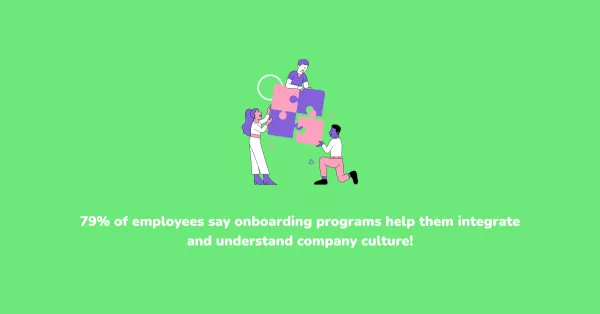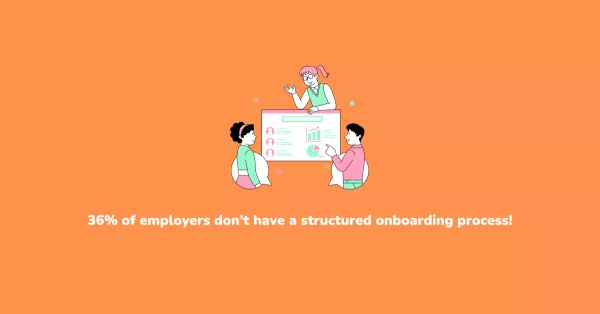Onboarding is a crucial yet often underestimated aspect of the employee journey that can significantly impact an organization's success. The true challenge lies in integrating new employees into your organization effectively. This is where it becomes a crucial process. Imagine starting a new job and feeling lost, unsure of your responsibilities, or not knowing whom to approach for guidance. It can be overwhelming and even discouraging. An effective plan ensures that new hires not only feel welcomed but are also equipped with the knowledge and tools they need to succeed from day one.
It is more than just paperwork and introductions; it’s about creating a foundation for long-term success. A well-structured onboarding program can enhance employee engagement, reduce turnover, and even boost productivity. When new hires understand their role, your company culture, and how they contribute to the organization’s goals, they are more likely to feel connected and committed to their work. In contrast, a poor plan can lead to confusion, frustration, and ultimately, early departures. As a business, you can’t afford to overlook the importance, it’s an investment in your people that pays off in the form of a cohesive, motivated, and high-performing team.
Onboarding Definition
Onboarding is more than just an HR buzzword; it’s a strategic process that can make or break your new hires’ experience with your company. So, what exactly is onboarding? In essence, it’s the process of integrating new employees into your organization and helping them become productive members of the team. It goes beyond merely filling out forms and going through a generic orientation session. It is about familiarizing new employees with your company’s culture, values, policies, and the specifics of their role.
Imagine it as a bridge between recruitment and full integration into the workplace. It involves several stages, starting from the moment a candidate accepts the job offer and continuing well into their first few months on the job. During this time, you’re not just teaching them how to use the office coffee machine or where the breakroom is. You’re setting the tone for their entire journey with your company. A good comprehensive onboarding process ensures that new hires feel welcomed, engaged, and prepared to tackle their responsibilities effectively.
A successful onboarding program typically includes several key elements. First, there’s the pre-boarding phase, which takes place before the new hire’s first day. This is your chance to send out welcome emails, share important documents, and even assign a mentor or buddy to ease their transition. Then comes the orientation, where you’ll introduce them to the company’s mission, values, and culture. This phase is crucial for helping them understand not just what they’ll be doing, but why their role matters in the larger scheme of things.
Next, you’ll move on to role-specific training. This is where you provide the tools and resources necessary for new hires to perform their job effectively. Whether it’s learning how to use company software or understanding team workflows, this training is tailored to their specific position. The final stage is ongoing support and feedback, which can last several months. During this period, you’ll check in regularly to see how they’re adjusting, offer constructive feedback, and answer any questions they might have.
It’s important to remember that this isn’t a one-size-fits-all process. It should be customized to fit the needs of both your organization and the individual employee. For instance, onboarding a senior manager will look very different from an entry-level employee. The key is to make the experience as smooth and informative as possible, so new hires can hit the ground running and feel like a valued part of the team from day one.
Investing in a solid onboarding process shows new employees that you’re committed to their success. It sets clear expectations, provides necessary resources, and most importantly, helps them feel connected to your organization. When employee onboarding is without mistakes, it can significantly reduce the time it takes for new hires to reach their full potential, ensuring that they contribute positively to your company’s goals sooner rather than later. So, if you’re looking to boost employee satisfaction, retention, and productivity, focusing on your onboarding process is a great place to start.
Benefits of a Strong Onboarding Process

Investing in an effective onboarding process is one of the smartest moves you can make as an employer. It’s not just about welcoming new hires, it’s about setting them up for success right from the start. An effective process offers numerous benefits that can significantly impact your organization’s productivity, employee satisfaction, and overall success.
Enhanced Employee Engagement
A well-designed process helps new hires feel valued and connected to your organization from day one. When you take the time to introduce them to your company culture, mission, and values, they’re more likely to feel a sense of belonging and purpose. Engaged employees are more motivated, enthusiastic, and willing to go the extra mile, which ultimately boosts overall performance.
Increased Productivity
Imagine a scenario where a new hire is left to figure things out on their own, without proper guidance or support. It can take weeks, if not months, for them to become fully productive. A structured program, on the other hand, provides them with the necessary tools, resources, and knowledge to start contributing effectively much sooner. When you clearly outline expectations and provide the training they need, you’re helping them reach their full potential faster.
Reduced Employee Turnover
Employee turnover can be costly, not just in terms of money, but also time and morale. High turnover rates often indicate that something is amiss with your process. New employees are most likely to leave within the first six months if they feel unsupported or disconnected. A comprehensive program can reduce this risk by making sure they feel welcome, informed, and prepared for their role. This kind of support encourages long-term commitment and loyalty to your company.
Stronger Workplace Relationships
Building good relationships with colleagues and supervisors is crucial for any new employee. It provides an excellent opportunity to facilitate these connections through activities like team introductions, mentoring programs, and social events. When new hires have a support system and know who to turn to for help, they’re more likely to feel comfortable and confident in their new environment.
Better Compliance and Reduced Errors
This is also an ideal time to educate new hires about company policies, legal requirements, and ethical standards. This helps prevent potential compliance issues down the road. When employees are well-informed about the do’s and don’ts from the beginning, they’re less likely to make mistakes that could have serious consequences for your business.
Improved Company Reputation
Word-of-mouth is powerful, and your process can significantly influence how your company is perceived in the job market. A positive experience can turn new hires into brand ambassadors who will speak highly of your company, attracting more top talent. On the flip side, a poor experience can harm your reputation, making it harder to recruit the best candidates in the future.
Faster Time-to-Competency
With a structured process, new hires can gain the knowledge and skills they need more quickly. This accelerated learning curve means they can start making meaningful contributions to your team in a shorter period. When they understand their role, know where to find resources, and have a clear sense of their responsibilities, they’re able to work more efficiently and effectively.
A strong process is a win-win for both you and your employees. It not only helps new hires feel comfortable and confident but also aligns them with your company’s goals and expectations from the very beginning. By investing in a comprehensive and engaging onboarding program, you’re building a solid foundation for long-term success and ensuring that your new hires become valuable, contributing members of your team. Whether you’re looking to boost productivity, reduce turnover, or improve employee satisfaction, a well-executed process is an essential step in achieving those goals.
Your Comprehensive Onboarding Checklist
A strong onboarding plan is essential for setting up new employees for success, and having a well-defined checklist can help ensure that no crucial steps are overlooked. This checklist will guide you through the journey, from the pre-boarding phase to the first few months of employment, ensuring that your new hires feel welcomed, informed, and prepared to excel in their roles.
Pre-Boarding - Setting the Stage
Before your new employee even steps through the door, there are several things you can do to make their transition smoother and more welcoming:
-
Send a Welcome Email - Start by sending a personalized welcome email. This should include a brief overview of what they can expect on their first day, the schedule, and any documents they need to review or complete beforehand.
-
Prepare Their Workspace - Make sure their workstation is set up with all the necessary equipment, including a computer, phone, and any other tools they’ll need. Adding a welcome kit with company swag, a personalized note, or helpful resources can also make a great first impression.
-
Assign a Buddy or Mentor - Having someone they can turn to for questions or guidance during their first few weeks can make a huge difference in their comfort and confidence levels.
Day One - Making a Great First Impression
The first day sets the tone for the rest of their time with your company, so it’s crucial to make it a positive experience:
-
Greet Them Warmly - Have someone from their team or HR meet them at the door, show them around the office, and introduce them to their colleagues.
-
Provide a Company Overview - Schedule a meeting to go over the company’s mission, vision, and values. Explain how their role fits into the bigger picture and contributes to the company’s success.
-
Discuss Policies and Procedures - Cover essential topics like attendance, dress code, and workplace safety. It’s also a good time to review the employee handbook and ensure they understand company policies.
Week One - Building the Foundation
The first week is all about helping your new hire get comfortable with their role and the company culture:
-
Role-Specific Training - Start with an in-depth training session on their specific responsibilities. This might include shadowing experienced team members, completing training modules, or hands-on practice with relevant tools and systems.
-
Set Clear Expectations - Outline their short-term goals and expectations for the first few months. This will help them understand what success looks like in their role and give them a sense of direction.
-
Introduce Key Stakeholders - Arrange meetings with key team members and stakeholders they’ll be working with. This will help them build relationships and understand how different departments interact.
First Month - Encouraging Engagement and Learning
As your new hire settles into their role, focus on continuous learning and integration:
-
Regular Check-Ins - Schedule weekly check-ins to discuss their progress, address any concerns, and offer feedback. This is also a good time to ask for their feedback on the onboarding plan and make any necessary adjustments.
-
Ongoing Training - Provide opportunities for further training and development. This could include additional role-specific training, cross-training with other departments, or even informal lunch-and-learn sessions on various topics.
-
Encourage Social Interaction - Organize team lunches or social events to help them get to know their colleagues better and feel more integrated into the company culture.
First Three Months - Solidifying the Relationship
During the first few months, your focus should be on reinforcing their commitment and ensuring they feel supported:
-
Set Long-Term Goals - Work with them to set more comprehensive performance goals and development plans for the coming year. This will help them see a clear path for growth within the company.
-
Encourage Feedback - Continue to solicit feedback on their experience and address any lingering concerns they might have. Showing that you value their input can significantly enhance their sense of belonging and satisfaction.
-
Celebrate Milestones - Recognize their contributions and achievements, no matter how small. Acknowledging their efforts can boost their morale and motivate them to continue performing at a high level.
Beyond Three Months - Continuous Support and Development
It doesn’t stop after the first few months. Continuous support and development are key to retaining top talent:
-
Regular Performance Reviews - Schedule formal performance reviews at the three- and six-month marks. This helps ensure they are on track with their goals and provides an opportunity to address any challenges.
-
Provide Development Opportunities - Encourage them to participate in training programs, workshops, or professional development courses. This shows your commitment to their growth and helps them build valuable skills.
-
Encourage Networking - Support their involvement in industry events, conferences, or networking groups. This can help them build connections, gain new insights, and bring fresh ideas back to the team.
By following this comprehensive onboarding checklist, you’re not just welcoming a new employee, you’re laying the groundwork for a successful, long-term relationship. A thoughtful and well-executed onboarding plan can make all the difference in how quickly and effectively new hires integrate into your team, ultimately contributing to their satisfaction, performance, and retention.
Why Use Employee Onboarding Software?

In an age where technology permeates every aspect of business, leveraging employee onboarding software can streamline and enhance your onboarding plan. So why should you consider investing in such tools? Here are several compelling reasons:
Increased Efficiency
Onboarding software automates many of the tedious administrative tasks involved in the process, such as document management, training schedules, and progress tracking. By digitizing these elements, you free up valuable time for HR personnel and managers to focus on more strategic activities, such as fostering relationships with new hires.
Consistency and Standardization
Using onboarding software ensures that every new employee receives the same high-quality experience, regardless of their role or department. This consistency helps reinforce your company’s culture and values and ensures that all essential information and training are covered uniformly.
Enhanced Engagement
Many onboarding software solutions offer interactive features such as video tutorials, quizzes, and social forums, making the experience more engaging for new hires. Engaging tools can make the learning process more enjoyable and memorable, leading to better retention of information.
Data-Driven Insights
This software often comes equipped with analytics features that allow you to track new hires’ progress and gather feedback on their experience. These data insights can help you identify areas for improvement, ensuring that your process continually evolves to meet the needs of your employees.
Flexibility and Accessibility
With this software, your new hires can access training materials and complete tasks at their own pace, regardless of their location. This flexibility is particularly beneficial in today’s hybrid work environment, allowing employees to engage with the process in a way that suits their schedules.
In summary, utilizing specialized software not only improves the efficiency and consistency of your onboarding plan but also enhances the overall experience for new hires. By embracing technology in your efforts, you’re investing in the success and satisfaction of your employees from day one.
Why OrangeHRM?
When it comes to streamlining your onboarding process, OrangeHRM stands out as a powerful solution designed to help you onboard new hires effortlessly. With OrangeHRM, you can easily track progress, gather valuable feedback, and ensure that every new employee receives a seamless experience tailored to your organization’s unique needs. Experience the difference that efficient onboarding can make for your team. Book a FREE demo today to see how OrangeHRM can transform your onboarding process!
